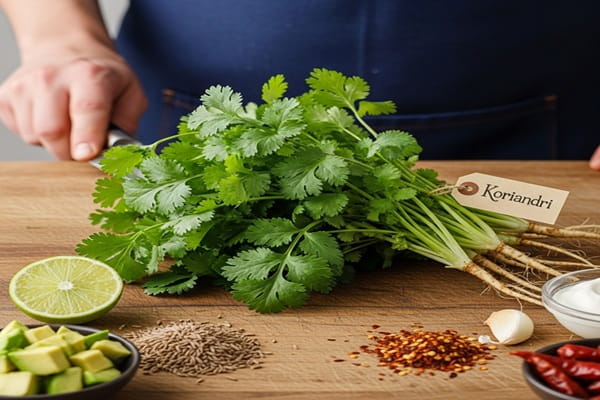In the wide, flavorful garden of global cuisine, few ingredients divide opinion like the humble leaf known by many names: cilantro, Chinese parsley, coriander leaf, or—if you’re in Greece and some other countries—koriandri.
For some, koriandri is a burst of fresh, citrusy magic, elevating every dish it touches. For others, it’s a soapy, overpowering presence that ruins meals in an instant. This tiny, lacy-leafed herb is more than just an ingredient; it’s a culinary paradox, a bridge between culture, geography, and genetics.
From Root to Leaf: Understanding Coriander
Confusion often starts with the name. The plant Coriandrum sativum produces two distinct flavors:
-
Coriander seeds: Small, round, warm, and slightly citrusy, these seeds are versatile in curries, baked goods, and pickling. They’re beloved worldwide and rarely spark controversy.
-
Fresh leaves and stems (koriandri/cilantro): This is where the drama begins. Bold, fragrant, and complex, these greens offer a bright lemony taste paired with an earthy punch. It’s the aldehyde in the leaves that triggers a soapy taste for some people—a genetic quirk rather than poor cooking.
This contrast between the seeds and the fresh leaves is what makes coriander such an intriguing culinary story.
A Global Herb With Ancient Roots
Koriandri’s culinary passport stretches across the globe and centuries:
-
Ancient origins: Evidence of coriander dates back millennia—traces were found in Egyptian tombs, and early Sanskrit texts mention it.
-
Greek cuisine: Known as koriandri, it’s essential in dishes like fassolakia yiahni (green bean stew). You’ll also find it chopped into meatballs, seasonal vegetables, or sprinkled over soups as a fragrant finishing touch.
-
Latin American cuisine: Here, cilantro is indispensable—fresh in salsas, topping tacos, blended into chimichurri, or spicing up pozole.
-
Asian cuisine: In India (dhania), Vietnam (fresh pho garnishes), and Thailand (spicy salads), it balances heat and adds freshness.
Interestingly, this global journey highlights a cultural divide:
-
The soapy taste appears more frequently among people of East Asian, African, and Caucasian descent.
-
Those from Latin American, South Asian, and Middle Eastern backgrounds are more likely to embrace it, having woven it into their cuisines for generations.
Embracing the Koriandri Divide
Whether you’re a lover or hater, there’s a way to appreciate (or at least navigate) this herb.
For the Lovers:
-
Treat koriandri as a fresh herb, not a cooked one. Add it at the end of cooking or use it raw to preserve its delicate oils.
-
Don’t discard the stems—they’re potent and perfect for marinades, dressings, or blended sauces.
-
Think of koriandri as a flavor boost—a pinch can transform soups, salads, tacos, and more.
For the Haters:
-
If it tastes soapy, blame your genes—it’s not your taste buds’ fault.
-
Crushing the leaves gently in a mortar and pestle instead of chopping can break down the offending compounds.
-
Try the seeds or dried coriander—they carry a similar citrusy warmth without the soapiness.
The Science Behind the Soapy Taste
So why does koriandri taste soapy to some people? It’s all down to aldehydes, a chemical compound in the leaves.
-
About 10-20% of the population is sensitive to this compound, making it taste sharply soapy.
-
Genetics dictate whether you’re a lover or a hater, showing that taste is deeply personal.
-
Interestingly, cooking the leaves slightly or pairing them with acidic flavors like lime or lemon can mute the soapy sensation.
Culinary Uses Across the World
Koriandri isn’t just an herb; it’s a global flavor connector. Here’s how chefs and home cooks use it:
-
Greek cuisine: Flavoring stews, vegetables, and meats.
-
Latin American kitchens: A star in salsas, tacos, and fresh sauces.
-
Indian dishes: Mixed into chutneys, curries, and garnishes for color and freshness.
-
Southeast Asia: Adding balance to spicy soups, salads, and noodle dishes.
Its versatility explains why, despite polarizing opinions, koriandri remains a beloved ingredient across continents.
Tips for Cooking With Koriandri
Whether you’re a first-timer or a seasoned fan, these tips make koriandri shine:
-
Add it last: Preserve the fresh, volatile oils.
-
Use stems, too: They’re packed with flavor.
-
Pair wisely: Citrus, tomatoes, and spicy flavors enhance its brightness.
-
Experiment with form: Fresh leaves for garnish, seeds for cooking, and even crushed leaves in sauces.
For hater-friendly alternatives, consider parsley or basil—similar texture but without the aldehyde-induced soapiness.
Also Read : Candizi: A Comprehensive Guide to Its Meaning, Uses, and Cultural Significance
Cultural Significance: More Than Just Flavor
Koriandri’s story is about more than taste—it’s a bridge between history, culture, and identity.
-
It connects ancient civilizations with modern kitchens.
-
Its polarizing flavor sparks conversations about genetics and food preference.
-
It illustrates how a single herb can carry centuries of culinary knowledge across continents.
A Leaf With Personality
Whether you love it or loathe it, koriandri makes food memorable. It’s bold, bright, and unapologetically assertive—a culinary character that can make or break a dish.
It reminds us that flavor isn’t universal—it’s biological, cultural, and deeply personal. And that’s what makes cooking, eating, and sharing food so endlessly fascinating.
Final Thoughts: Sprinkle With Care
Koriandri is more than a garnish; it’s a symbol of taste, culture, and heritage.
-
For some, it’s the heart of a meal.
-
For others, it’s a lesson in genetics and personal preference.
-
Either way, this humble herb connects ancient traditions with modern kitchens, from Greek stews to Mexican salsas to Vietnamese pho.
So, the next time you see those lacy green leaves, remember: a single pinch can elevate a dish—or spark a lively debate at the table.
Koriandri isn’t just food—it’s a conversation, a culture, and a global flavor story in one vibrant leaf.
